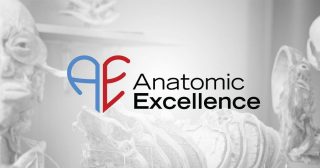Evidence-Based Benefits of Plastination
Accolades from Academics & Practitioners

The Benefits of a Blended Learning Approach
Plastinated specimens have long been lauded by academics and practitioners as being enormously beneficial as stand-alone teaching tools as well as complementary resources to traditional teaching strategies, particularly wet dissection. Following, please find numerous citations from scientists and scholars, grouped by relevant category:
DISSECTION / PROSECTION
- Gunther von Hagens created plastination to create prosected specimens for educational use that are easier to handle and study from than traditional anatomical specimens. Unlike cadavers and prosections, his products are odorless and inert, which can be handled without gloves and do not require any special storage requirements (Bickley et al., 1981; von Hagens, 1979; von Hagens et al, 1987).
- Several published papers support that the use of plastination in conjunction with dissection as beneficial to students learning because it provides authentic, durable, and relevant anatomical relationships of difficult-to-dissect structures (Nodim, 1996; Latorre et al., 2007a; Cornwall, 2011; Fruhstorfer et al., 2011; Neha et al., 2013; Riederer, 2014b; Latorre et al., 2016).
- Plastinates can be used for dissections that are too difficult to perform during the time constraints of the modern medical curriculum (Riederer, 2014b).
- The use of plastination in this regard could then support 3D representations of anatomical relationships that are extremely helpful to learning and retaining anatomy (Abid et al., 2010; Estevez et al., 2010; McNeill, 2011; Preece et al., 2013; Baskaran et al, 2016).
- Plastinated specimens preserve anatomical relationships that are difficult for learners to comprehend, such as neuroanatomy, which reduces the loss of true anatomical alignment associated with wet specimens (Estevez et al., 2010; Silva and Andrade, 2016).
- Some schools have completely replaced dissection with plastinated prosections and have found promising results in the adequacy of students’ anatomical knowledge (Hoffmann et al., 2010; Baker et al., 2013).
- The use of plastinated specimens in undergraduate dental education has been linked to an increase in student satisfaction, an increase in students long-term retention of anatomical knowledge evidenced by an improvement in high stakes test scores and a more efficient use of anatomy department resources (Baker et al, 2013).
- Some institutions have switched to using living anatomy and imaging (McLachlan & Patten, 2006) or virtual learning packages (Durham et al, 2009).
CLINICAL ANATOMY
The use of plastinates during clinical anatomy teaching sessions can help with integration of 3D organization of the human body. Furthermore, plastinates are ideal tools for use outside of the dissection room for reference during small-group teaching without the need for special conditions (Latorre et al., 2016).
DIGITAL RENDERING / IMAGING / 3D MODELS
- A study by Purinton (1991) supports the use of plastinates to supplement computer assisted learning due to its ability to help students synthesize gross anatomy of the brain with histological slides of the same structures. Not only this, but the dryness of plastinates allow hands-on use and eliminates the risk of damaging electronic equipment during digital learning (Lozanoff et al., 2003).
- Similarly, to digital methods of learning anatomy, plastinates can be used in congruence with medical imaging to aid in synthesizing what students learn in cadaver lab with what they are seeing on an MRI or the ultrasound screen. A study comparing the use of sliced plastinated hearts in congruence with imaging the heart through ultrasound reported that the plastinates provided a contextual view of the internal structures of the heart and their complex anatomical relationships that corresponded with the 2D ultrasound parasternal images of the heart (Gomez et al., 2012).
- Some argue that plastic models are inherently impractical to study anatomy because they are subject to artistic renderings that may or may not be anatomically correct. Lozanoff argues that plastination provides students with authentic anatomy as well as showcasing common anatomical variations (Lozanoff et al., 2003).

